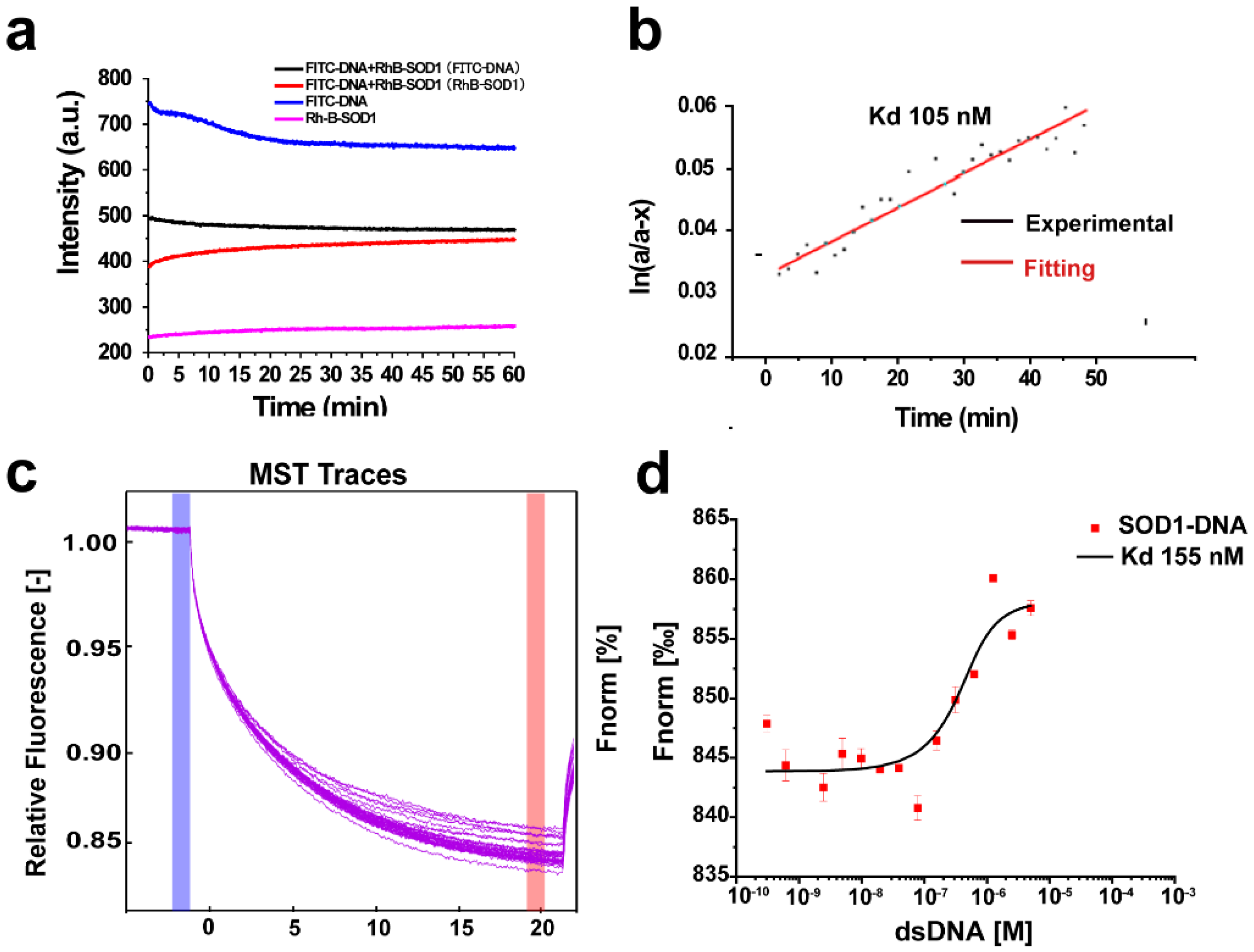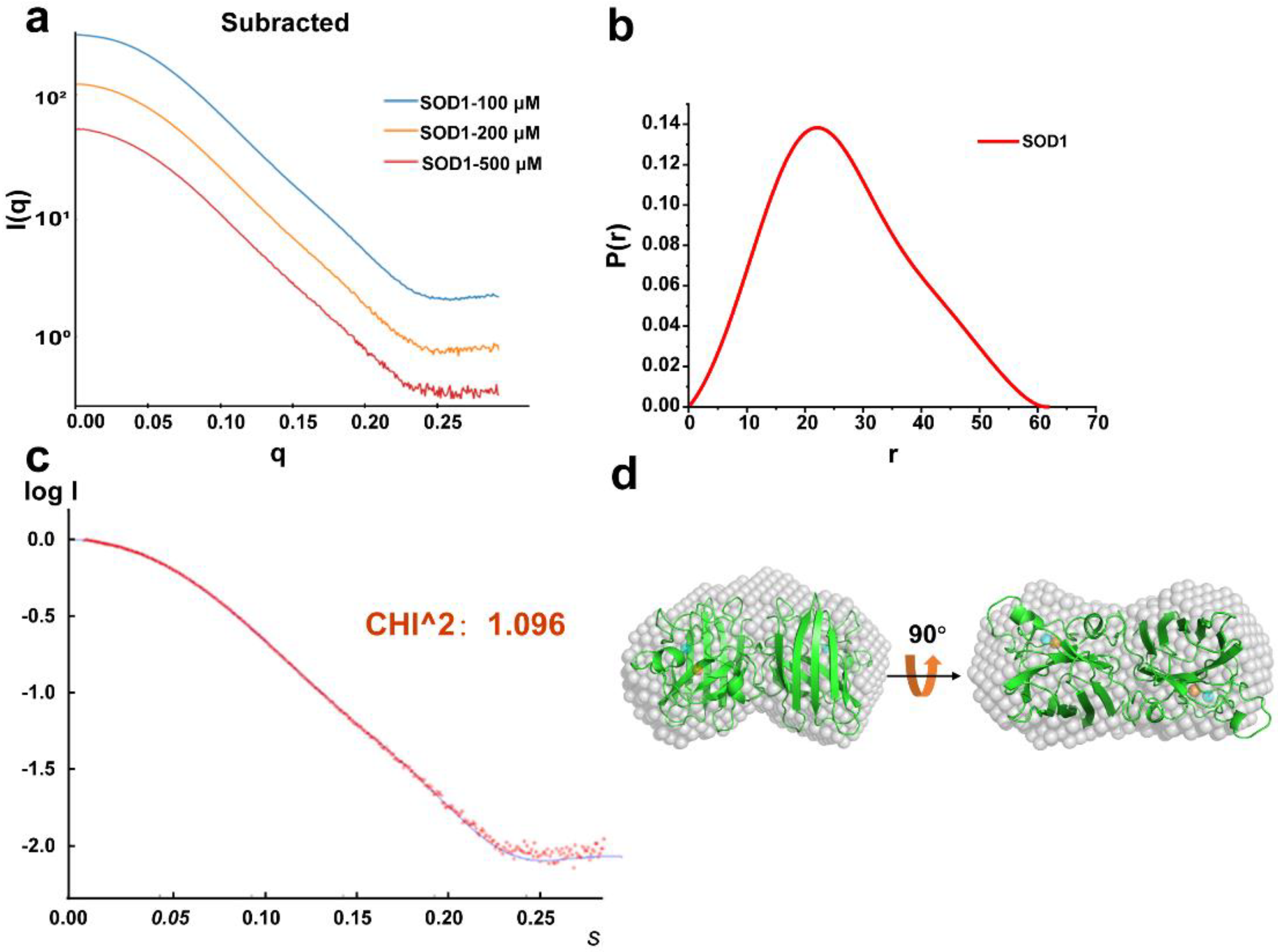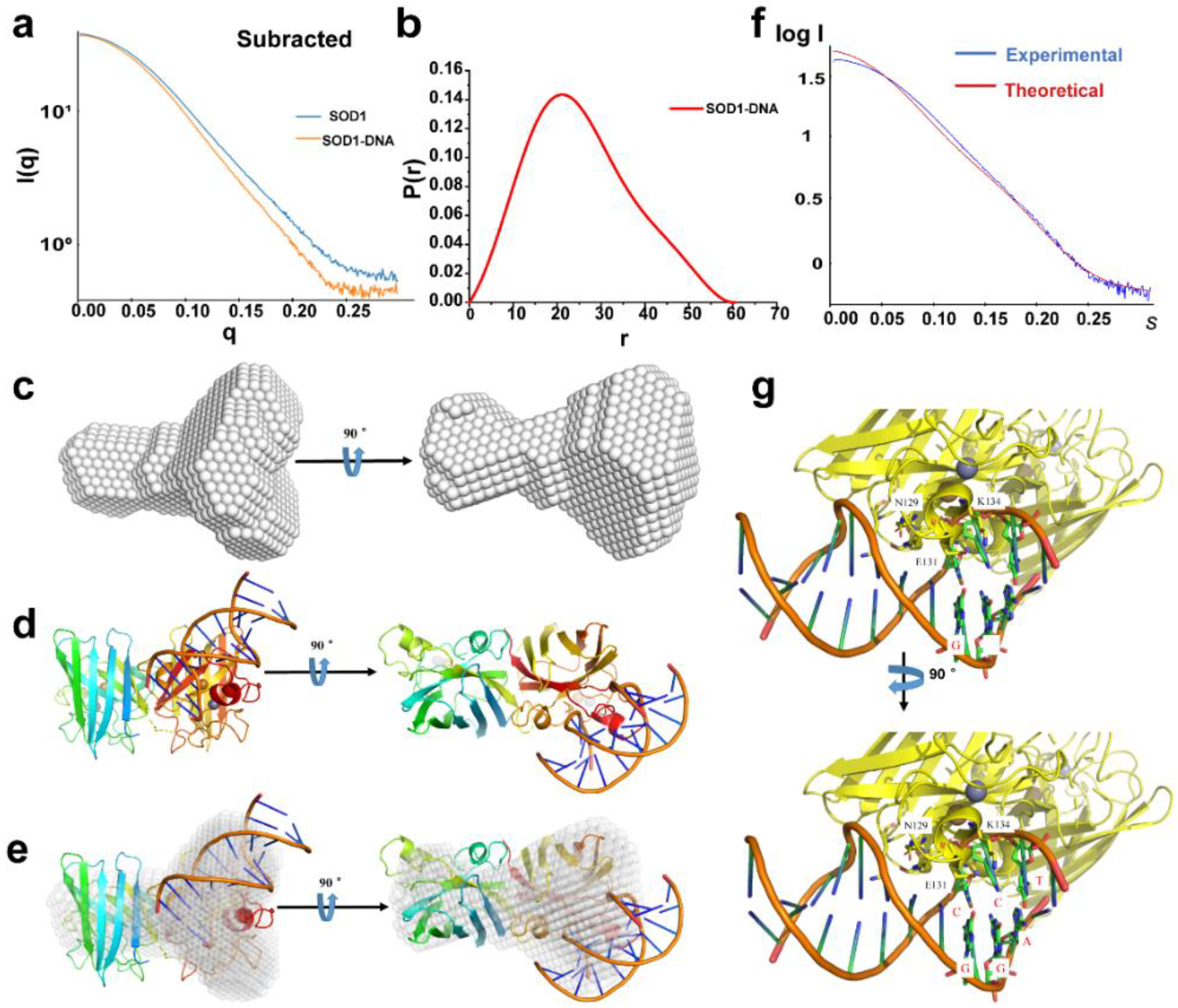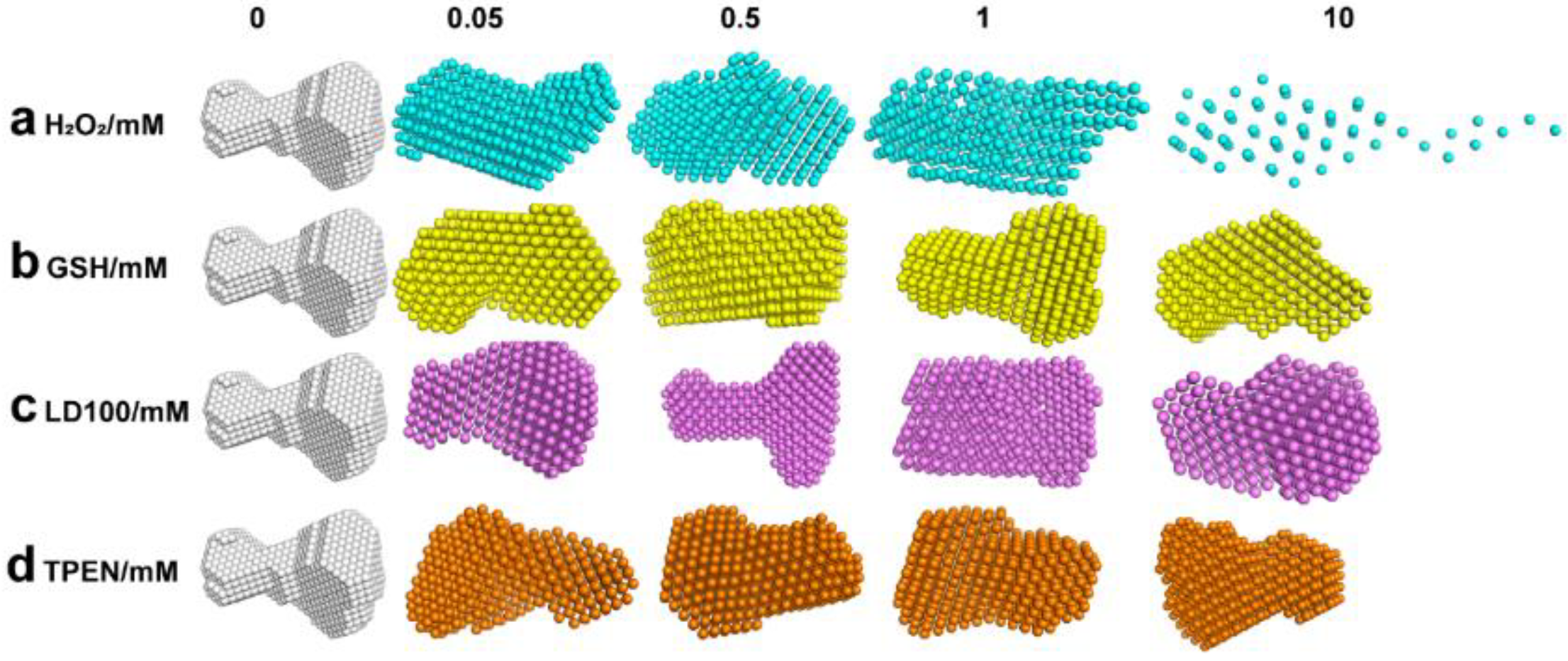SAXS Examinations of the Redox-Dependent Formation of a DNA-SOD1 Complex
Abstract
1. Introduction
2. Results and Discussion
2.1. Determination of the Binding Constant of SOD1 to dsDNA
2.2. SAXS Characterization of the Mixture of SOD1 and dsDNA
2.3. Effect of Redox Conditions on the Formation of the dsDNA-SOD1 Complex
3. Materials and Methods
3.1. Human SOD1 Expression and Purification
3.2. Fluorescence Resonance Energy Transfer (FRET)
3.3. Microscale Thermophoresis (MST) Assay
3.4. Small-Angle X-ray Scattering (SAXS)
3.5. HADDOCK Docking
3.6. Circular Dichroism Spectra
4. Conclusions
Supplementary Materials
Author Contributions
Funding
Institutional Review Board Statement
Informed Consent Statement
Data Availability Statement
Acknowledgments
Conflicts of Interest
References
- Sheng, Y.; Abreu, I.A.; Cabelli, D.E.; Maroney, M.J.; Miller, A.F.; Teixeira, M.; Valentine, J.S. Superoxide dismutases and superoxide reductases. Chem. Rev. 2014, 114, 3854–3918. [Google Scholar] [CrossRef] [PubMed]
- Gao, Z.; Sarsour, E.H.; Kalen, A.L.; Li, L.; Kumar, M.G.; Goswami, P.C. Late ROS accumulation and radiosensitivity in SOD1-overexpressing human glioma cells. Free Radic. Biol. Med. 2008, 45, 1501–1509. [Google Scholar] [CrossRef]
- McCord, J.M.; Fridovich, I. Superoxide dismutase. An enzymic function for erythrocuprein (hemocuprein). J. Biol. Chem. 1969, 244, 6049–6055. [Google Scholar] [CrossRef]
- Giorgio, M.; Trinei, M.; Migliaccio, E.; Pelicci, P.G. Hydrogen peroxide: A metabolic by-product or a common mediator of ageing signals? Nat. Rev. Mol. Cell Biol. 2007, 8, 722–728. [Google Scholar] [CrossRef] [PubMed]
- D’Autréaux, B.; Toledano, M.B. ROS as signalling molecules: Mechanisms that generate specificity in ROS homeostasis. Nat. Rev. Mol. Cell Biol. 2007, 8, 813–824. [Google Scholar] [CrossRef] [PubMed]
- Reddi, A.R.; Culotta, V.C. SOD1 integrates signals from oxygen and glucose to repress respiration. Cell 2013, 152, 224–235. [Google Scholar] [CrossRef] [PubMed]
- Wang, X.; Zhang, H.; Sapio, R.; Yang, J.; Wong, J.; Zhang, X.; Guo, J.Y.; Pine, S.; Van Remmen, H.; Li, H.; et al. SOD1 regulates ribosome biogenesis in KRAS mutant non-small cell lung cancer. Nat. Commun. 2021, 12, 2259. [Google Scholar] [CrossRef]
- Li, X.; Chen, Y.; Zhao, J.; Shi, J.; Wang, M.; Qiu, S.; Hu, Y.; Xu, Y.; Cui, Y.; Liu, C.; et al. The Specific Inhibition of SOD1 Selectively Promotes Apoptosis of Cancer Cells via Regulation of the ROS Signaling Network. Oxidative Med. Cell. Longev. 2019, 2019, 9706792. [Google Scholar] [CrossRef]
- Dong, X.; Zhang, Z.; Zhao, J.; Lei, J.; Chen, Y.; Li, X.; Chen, H.; Tian, J.; Zhang, D.; Liu, C.; et al. The rational design of specific SOD1 inhibitors via copper coordination and their application in ROS signaling research. Chem. Sci. 2016, 7, 6251–6262. [Google Scholar] [CrossRef]
- Jiang, W.; Shen, T.; Han, Y.; Pan, Q.; Liu, C. Divalent-metal-dependent nucleolytic activity of Cu, Zn superoxide dismutase. J. Biol. Inorg. Chem. 2006, 11, 835–848. [Google Scholar] [CrossRef]
- Jiang, W.; Han, Y.; Zhou, R.; Zhang, L.; Liu, C. DNA is a template for accelerating the aggregation of copper, zinc superoxide dismutase. Biochemistry 2007, 46, 5911–5923. [Google Scholar] [CrossRef]
- Jiang, W.; Zhang, B.; Yin, J.; Liu, L.; Wang, L.; Liu, C. Polymorphism of the SOD1-DNA aggregation species can be modulated by DNA. Biopolymers 2008, 89, 1154–1169. [Google Scholar] [CrossRef]
- Yin, J.; Hu, S.; Jiang, W.; Liu, L.; Lan, S.; Song, X.; Liu, C. DNA-triggered aggregation of copper, zinc superoxide dismutase in the presence of ascorbate. PLoS ONE 2010, 5, e12328. [Google Scholar] [CrossRef]
- Zhao, D.; Zhang, S.; Meng, Y.; Xiongwei, D.; Zhang, D.; Liang, Y.; Wang, L.; Liu, C. Polyanion binding accelerates the formation of stable and low-toxic aggregates of ALS-linked SOD1 mutant A4V. Proteins 2014, 82, 3356–3372. [Google Scholar] [CrossRef]
- Hu, S.; Xie, Z.; Onishi, A.; Yu, X.; Jiang, L.; Lin, J.; Rho, H.S.; Woodard, C.; Wang, H.; Jeong, J.S.; et al. Profiling the human protein-DNA interactome reveals ERK2 as a transcriptional repressor of interferon signaling. Cell 2009, 139, 610–622. [Google Scholar] [CrossRef] [PubMed]
- Tsang, C.K.; Liu, Y.; Thomas, J.; Zhang, Y.; Zheng, X.F. Superoxide dismutase 1 acts as a nuclear transcription factor to regulate oxidative stress resistance. Nat. Commun. 2014, 5, 3446. [Google Scholar] [CrossRef]
- Li, X.; Qiu, S.; Shi, J.; Wang, S.; Wang, M.; Xu, Y.; Nie, Z.; Liu, C.; Liu, C. A new function of copper zinc superoxide dismutase: As a regulatory DNA-binding protein in gene expression in response to intracellular hydrogen peroxide. Nucleic Acids Res. 2019, 47, 5074–5085. [Google Scholar] [CrossRef]
- Shi, J.; Zhao, D.; Li, X.; Ding, F.; Tang, X.; Liu, N.; Huang, H.; Liu, C. The conjugation of rhodamine B enables carrier-free mitochondrial delivery of functional proteins. Org. Biomol. Chem. 2020, 18, 6829–6839. [Google Scholar] [CrossRef] [PubMed]
- Roy, P.; Rajfur, Z.; Pomorski, P.; Jacobson, K. Microscope-based techniques to study cell adhesion and migration. Nat. Cell. Biol. 2002, 4, E91–E96. [Google Scholar] [CrossRef] [PubMed]
- Jares-Erijman, E.A.; Jovin, T.M. FRET imaging. Nat. Biotechnol. 2003, 21, 1387–1395. [Google Scholar] [CrossRef]
- Wienken, C.J.; Baaske, P.; Rothbauer, U.; Braun, D.; Duhr, S. Protein-binding assays in biological liquids using microscale thermophoresis. Nat. Commun. 2010, 1, 100. [Google Scholar] [CrossRef]
- Rambo, R.P.; Tainer, J.A. Accurate assessment of mass, models and resolution by small-angle scattering. Nature 2013, 496, 477–481. [Google Scholar] [CrossRef]
- Bernadó, P.; Mylonas, E.; Petoukhov, M.V.; Blackledge, M.; Svergun, D.I. Structural characterization of flexible proteins using small-angle X-ray scattering. J. Am. Chem. Soc. 2007, 129, 5656–5664. [Google Scholar] [CrossRef] [PubMed]
- Hura, G.L.; Menon, A.L.; Hammel, M.; Rambo, R.P.; Poole, F.L., II; Tsutakawa, S.E.; Jenney, F.E.J.; Classen, S.; Frankel, K.A.; Hopkins, R.C.; et al. Robust, high-throughput solution structural analyses by small angle X-ray scattering (SAXS). Nat. Methods 2009, 6, 606–612. [Google Scholar] [CrossRef]
- Rambo, R.P.; Tainer, J.A. Super-resolution in solution X-ray scattering and its applications to structural systems biology. Annu. Rev. Biophys. 2013, 42, 415–441. [Google Scholar] [CrossRef]
- Schneidman-Duhovny, D.; Hammel, M.; Tainer, J.A.; Sali, A. FoXS, FoXSDock and MultiFoXS: Single-state and multi-state structural modeling of proteins and their complexes based on SAXS profiles. Nucleic Acids Res. 2016, 44, W424–W429. [Google Scholar] [CrossRef]
- Pelikan, M.; Hura, G.L.; Hammel, M. Structure and flexibility within proteins as identified through small angle X-ray scattering. Gen. Physiol. Biophys. 2009, 28, 174–189. [Google Scholar] [CrossRef]
- Hopkins, J.B.; Gillilan, R.E.; Skou, S. BioXTAS RAW: Improvements to a free open-source program for small-angle X-ray scattering data reduction and analysis. J. Appl. Crystallogr. 2017, 50, 1545–1553. [Google Scholar] [CrossRef] [PubMed]
- Franke, D.; Petoukhov, M.V.; Konarev, P.V.; Panjkovich, A.; Tuukkanen, A.; Mertens, H.D.T.; Kikhney, A.G.; Hajizadeh, N.R.; Franklin, J.M.; Jeffries, C.M.; et al. ATSAS 2.8: A comprehensive data analysis suite for small-angle scattering from macromolecular solutions. J. Appl. Crystallogr. 2017, 50, 1212–1225. [Google Scholar] [CrossRef] [PubMed]
- Svergun, D.I. Determination of the regularization parameter in indirect-transform methods using perceptual criteria. J. Appl. Crystallogr. 1992, 25, 495–503. [Google Scholar] [CrossRef]
- Yong, C.W.; Glab, J.; Strange, R.W.; Smith, W.; Hasnain, S.S.; Grossmann, J.G. Assessment of long-term molecular dynamics calculations with experimental information on protein shape from X-ray scattering—SOD1 as a case study. Chem. Phys. Lett. 2009, 481, 112–117. [Google Scholar] [CrossRef]
- Svergun, D.; Barberato, C.; Koch, M.H.J. CRYSOL—A Program to Evaluate X-ray Solution Scattering of Biological Macromolecules from Atomic Coordinates. J. Appl. Crystallogr. 1995, 28, 768–773. [Google Scholar] [CrossRef]
- van Zundert, G.C.P.; Rodrigues, J.; Trellet, M.; Schmitz, C.; Kastritis, P.L.; Karaca, E.; Melquiond, A.S.J.; van Dijk, M.; de Vries, S.J.; Bonvin, A. The HADDOCK2.2 Web Server: User-Friendly Integrative Modeling of Biomolecular Complexes. J. Mol. Biol. 2016, 428, 720–725. [Google Scholar] [CrossRef] [PubMed]
- Aravind, L.; Anantharaman, V.; Balaji, S.; Babu, M.M.; Iyer, L.M. The many faces of the helix-turn-helix domain: Transcription regulation and beyond. FEMS Microbiol. Rev. 2005, 29, 231–262. [Google Scholar] [CrossRef]
- Outten, C.E.; Outten, F.W.; O’Halloran, T.V. DNA distortion mechanism for transcriptional activation by ZntR, a Zn(II)-responsive MerR homologue in Escherichia coli. J. Biol. Chem. 1999, 274, 37517–37524. [Google Scholar] [CrossRef]




| Conditions | Construct | Concentrations (mM) | ||||
|---|---|---|---|---|---|---|
| 0 | 0.05 | 0.5 | 1 | 10 | ||
| H2O2 | I(0) (×105) | 52.74 ± 0.04 | 64.71 ± 0.06 | 60.63 ± 0.07 | 58.02 ± 0.09 | N/A |
| Rg (Å) | 19.36 ± 0.14 | 19.99 ± 0.15 | 19.93 ± 0.03 | 20.19 ± 0.04 | N/A | |
| Dmax (Å) | 60.41 | 67.76 | 67.91 | 69.92 | N/A | |
| GSH | I(0) (×105) | 52.74 ± 0.04 | 58.61 ± 0.06 | 57.09 ± 0.05 | 61.82 ± 0.06 | 55.86 ± 0.06 |
| Rg (Å) | 19.36 ± 0.14 | 19.41 ± 0.11 | 19.40 ± 0.18 | 19.36 ± 0.18 | 19.35 ± 0.05 | |
| Dmax (Å) | 60.41 | 61.02 | 60.91 | 61.04 | 61.01 | |
| TPEN | I(0) (×105) | 52.74 ± 0.04 | 57.38 ± 0.05 | 59.57 ± 0.03 | 58.27 ± 0.06 | 59.14 ± 0.05 |
| Rg (Å) | 19.36 ± 0.14 | 19.39 ± 0.03 | 19.40 ± 0.03 | 19.34 ± 0.04 | 19.34 ± 0.04 | |
| Dmax (Å) | 60.41 | 60.86 | 60.42 | 60.63 | 62.98 | |
| LD100 | I(0) (×105) | 52.74 ± 0.04 | 56.04 ± 0.07 | 56.94 ± 0.07 | 58.50 ± 0.13 | N/A |
| Rg (Å) | 19.36 ± 0.14 | 19.32 ± 0.06 | 19.35 ± 0.04 | 19.44 ± 0.06 | N/A | |
| Dmax (Å) | 60.41 | 61.32 | 63.12 | 67.54 | N/A | |
Publisher’s Note: MDPI stays neutral with regard to jurisdictional claims in published maps and institutional affiliations. |
© 2022 by the authors. Licensee MDPI, Basel, Switzerland. This article is an open access article distributed under the terms and conditions of the Creative Commons Attribution (CC BY) license (https://creativecommons.org/licenses/by/4.0/).
Share and Cite
Wang, H.; Wang, M.; Nie, Z.; Qiu, S.; Huang, X.; Li, X.; Cui, Y.; Liu, C.; Liu, C. SAXS Examinations of the Redox-Dependent Formation of a DNA-SOD1 Complex. Int. J. Mol. Sci. 2022, 23, 12673. https://doi.org/10.3390/ijms232012673
Wang H, Wang M, Nie Z, Qiu S, Huang X, Li X, Cui Y, Liu C, Liu C. SAXS Examinations of the Redox-Dependent Formation of a DNA-SOD1 Complex. International Journal of Molecular Sciences. 2022; 23(20):12673. https://doi.org/10.3390/ijms232012673
Chicago/Turabian StyleWang, Huiling, Mingfang Wang, Zefeng Nie, Shuang Qiu, Xiaoping Huang, Xiang Li, Yanfang Cui, Chunrong Liu, and Changlin Liu. 2022. "SAXS Examinations of the Redox-Dependent Formation of a DNA-SOD1 Complex" International Journal of Molecular Sciences 23, no. 20: 12673. https://doi.org/10.3390/ijms232012673
APA StyleWang, H., Wang, M., Nie, Z., Qiu, S., Huang, X., Li, X., Cui, Y., Liu, C., & Liu, C. (2022). SAXS Examinations of the Redox-Dependent Formation of a DNA-SOD1 Complex. International Journal of Molecular Sciences, 23(20), 12673. https://doi.org/10.3390/ijms232012673





